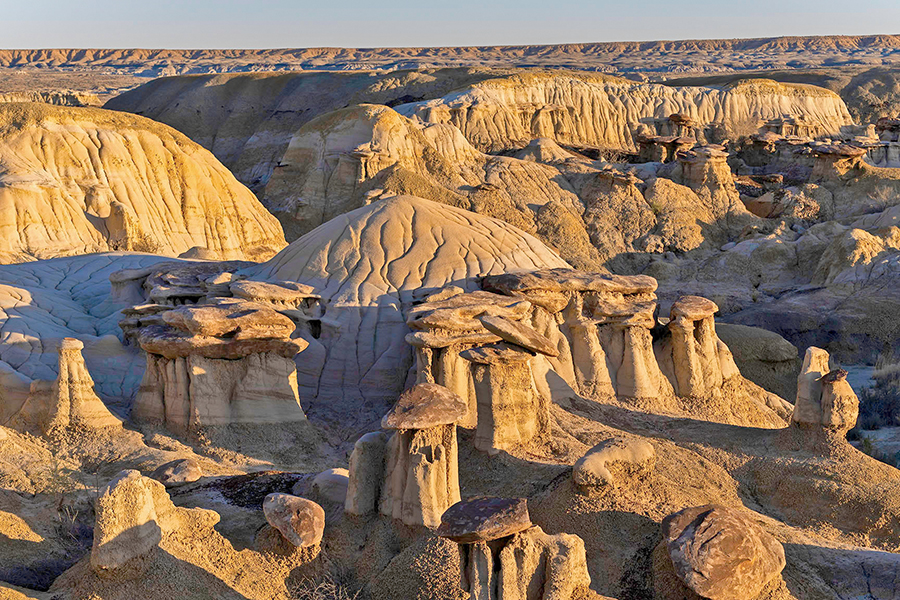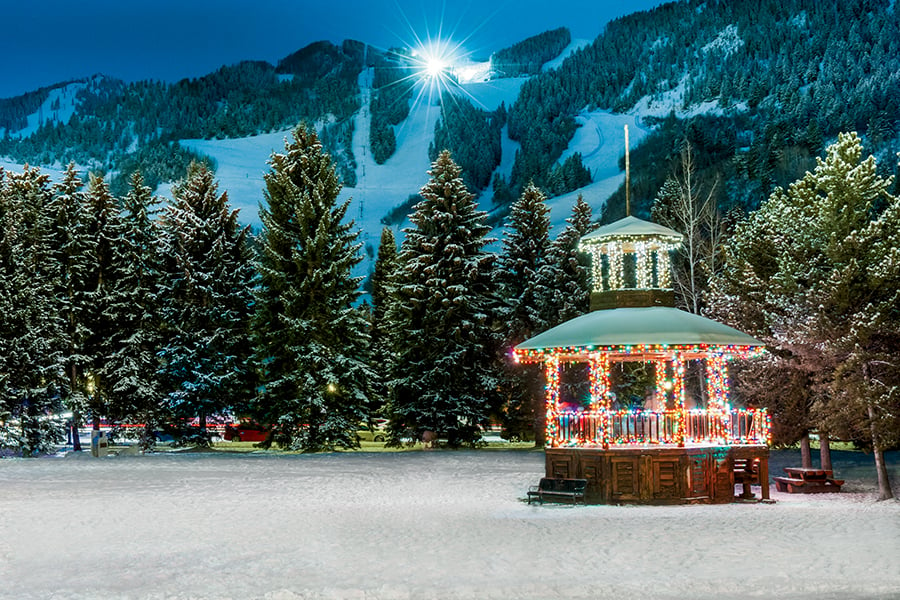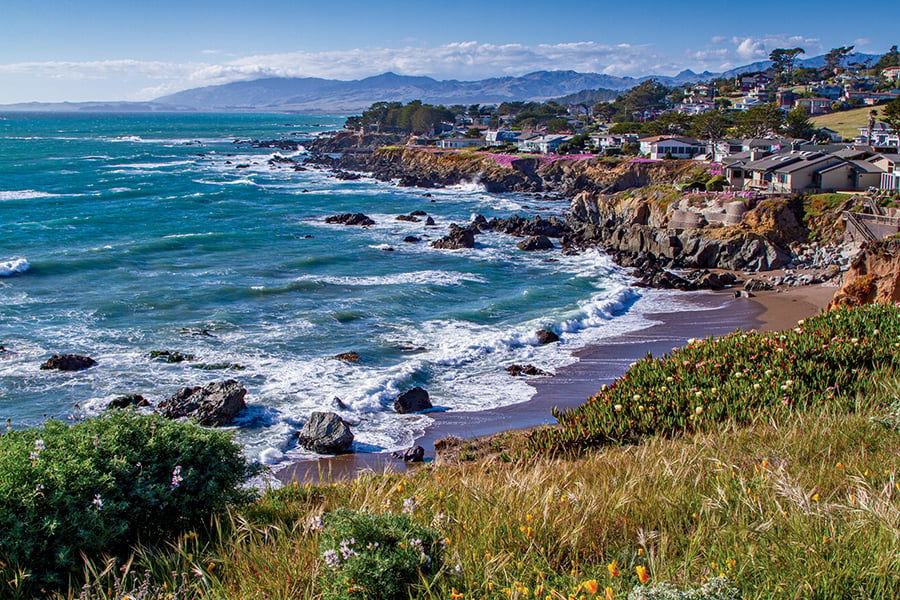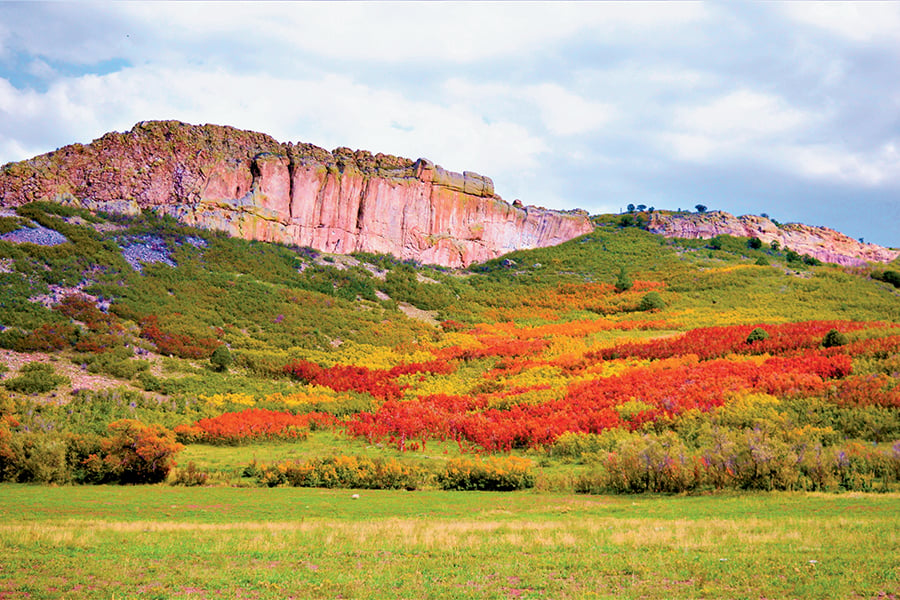Good times in the Badlands

Editor’s Note: This article was written based on the author’s experiences prior to the pandemic. Some of the lodgings, restaurants, and activities described in this article may be limited today. If you visit, please follow local, state, and federal safety protocols and social distancing practices to keep yourself and others protected.
No, not those Badlands in South Dakota—New Mexico’s Badlands. The northwest quadrant of New Mexico hides a wonderland of whimsically eroded pinnacles and hoodoos, long overlooked in the shadow of the hyper-dramatic landscapes of the Four Corners.
The Bisti Badlands (pronounced “Bis-tie”) is 45,000-acres of semi-wilderness with several areas of distinction, each with hundreds of beautifully eroded fantastical shapes: balanced rocks, fins, spires, and even arches. The names given to these shapes hint at their sculptural intensity: Alien Throne, King of Wings, Cracked Egg Nursery, and others. This fossil-rich region of San Juan County is slowly becoming more popular, especially to photographers, as a ‘new’ land to explore, making for strikingly graphic images—and it’s free for all to visit.
Exploring the Bisti
Navajo for “large area of shale hills,” you’ll need some serious route-finding skills, a working compass, and the ability to use small landmarks for navigation. Since this is a wilderness area, motorized vehicles, as well as bicycles, are prohibited; however, many of the best features can be seen with an easy 2- to 4-mile hike/walk. The hiking itself is rarely challenging, with little elevation gain or loss, but the lack of marked trails means you’ll need to pay close attention from where you started. Using a GPS device is helpful and will allow you to roam more of the area without getting lost.
The Bisti is rarely crowded, so practicing social distancing, once you’re a short distance from the trailheads, is easy to maintain with no set trails and miles of open country surrounding you. I savor the peace and quiet here on every visit.
Along the way, you’ll find some exposed petrified trees and myriad fragments scattered about the washes. Stargazers will value Bisti’s dark skies for viewing the Milky Way and endless constellations. The Bisti is distant enough from Santa Fe and Albuquerque to quell most light pollution, so bring your camera and a tripod to experiment with high ISOs and long-exposure photography—even the newest smartphones are good for capturing the stars!
When to visit
A big factor in planning your trip here is the weather. The Bisti Badlands sit in a high desert and are open year-round, but late-spring/early-summer and anytime during the fall are reasonably temperate times. The nights are cool, and dawn can be chilly, waiting for the sun to illuminate the hoodoos. The dirt roads through Bisti are graded and safe for passenger cars; however, thunderstorms can cause them to become slippery with some of the nastiest clay-rich mud in the West. Even a 4WD can have difficulty keeping traction after a good rain—and putting on chains in the cold mud is not something I ever want to do again. So, I recommend avoiding the summer monsoon season and soaking winter cold fronts.
A good egg
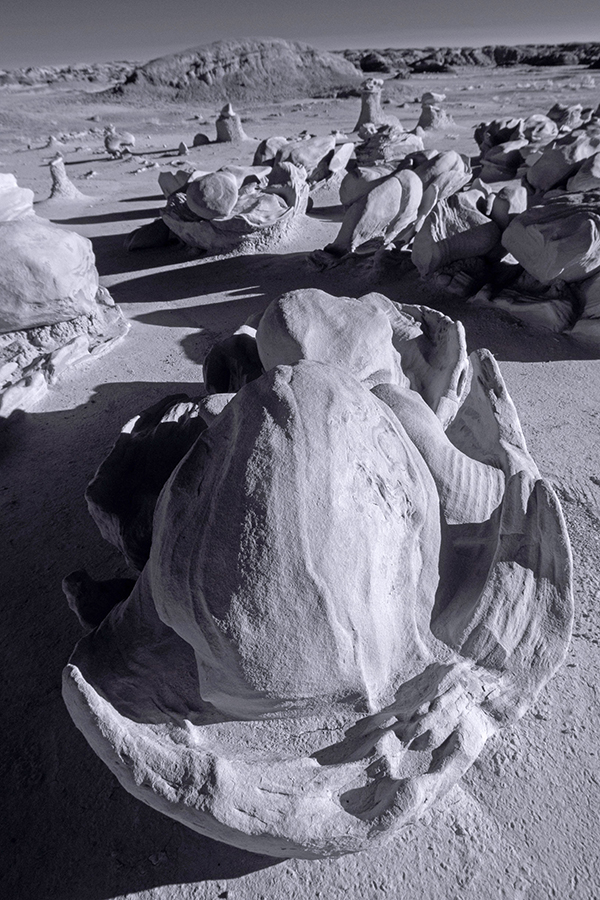
Large, egg-shaped natural sculptures in the Bisti’s Cracked Eggs Nursery are the result of erosive processes. © Kerrick James
There are three major areas of interest, and all are accessible from decent roads.
Most visitors will first experience the Bisti by driving 36 miles due south from Farmington, N.M., on Highway 371, then turning left on County Road 7297 (gravel) for 2 miles. Once you reach the T-intersection, turn left again, down a slight grade until you see the Bisti Access Parking Area. This is where the adventure to the first area of interest begins.
From here, hike east-northeast, up a very wide wash. On the south side, you’ll see eroded shapes that look as if they’re growing from the slopes. Feel free to explore this area before continuing your journey. About 2 miles in from the road you may stumble upon the fabled Cracked Egg Nursery. Note I said you may find the Cracked Egg Nursery, as it took me three visits to find this quite curious site without a GPS unit.
These large, egg-shaped natural sculptures are the result of erosive processes, like differential weathering. They seemingly look like they could be the ‘eggs’ of alien creatures. It’s fun to let your imagination run wild.
Where dinosaurs roamed
If you still have time and energy after searching for the Cracked Egg Nursery, move on east to the De-Na-Zin Wilderness Trailhead, on wide County Road 7500. It’s also accessible from U.S. Highway 550, driving south from Bloomfield, N.M., and you’ll encounter less dirt road from this direction.
From the trailhead, hike about 0.75 miles to enter the De-Na-Zin Wash. Here, you can find by far the biggest petrified trees in the Bisti, massive, nearly intact trunks up to 100-feet-long and almost 6-feet-wide at the base. Some are fully exposed, others half buried in tawny and ruddy sandstones. Know that where you stand large dinosaurs of many types roamed for millions of years, a Jurassic Park indeed.
Say what?
The third, and my photographic favorite, great Bisti site is not easy to pronounce: Ah-shi-sle-pah. This Wilderness Study Area features numerous side canyons, incised into a creamy, north-facing rim, offers solitude for a morning or day hike, has a variety of funky formations and petrified wood, and is allegedly rich in fossils. But you must be willing to search, to poke into nameless ravines, and scramble a bit to find some shade for a picnic and ponder the creatures that lived here millions of years ago in much wetter times.
None of the Bisti is Kodak VistaPoint country, meaning there are few signs, and none that point out named features. You simply have to glean info from other travelers’ online posts, go with someone who has been there, or venture out on your own—which is exactly how I found the seductively named Alien Throne.
A Jeep-addicted photo-buddy of mine, Harry Ford (not Harrison), did some online research to learn how to find this rare and delicately latticed tower, which allows the sun and stars to show through. We drove as far in as we dared on unnamed roads (more like cow-paths), parked his crimson Jeep Rubicon on a knife-edge ridge, then slid down a steep, reddish-broken slope, and worked our way west.
Harry had his GPS, but it didn’t take us the easy way. Still, we found some spectacular spires and ledges, and large trunks of petrified wood along the way. Suddenly, just as we were about to give up, there it was, the most arresting erosional feature I’ve seen in four decades of roaming the Southwest. Clouds began drifting in, portent of a coming storm, but we stayed until sunset and were rewarded with a gilded sky.
To access Ah-shi-sle-pah, I prefer heading south from Bloomfield on U.S. Highway 550; then about 7.5-miles north of Nageezi, turn right onto Highway 57. From here, drive another 13.5 miles, while watching out for livestock, and you’ll see Ah-shi-sle-pah unfold on your right. There’s a newish sign at the very small dirt parking lot indicating you’re here. Now, just grab your water and snacks and walk the 0.75-mile ranch single track until you see the first densely populated area of formations below.
If you go left along the rim, you’ll follow a faint trail down to the floor of the wash, where the visual playtime begins. You’ll spend several hours exploring the weirdly beautiful natural sculptures, but again a word to the wise, there are no tall, usable landmarks anywhere, so take note of your bearings often as you scatter.
Hidden treasure
At first glance, the Bisti appears to be a barren, unremarkable wasteland. But if you delve deeper, and take the time to appreciate its beauty and grandeur, you might find more pieces of lost creatures and stylish natural wonders. Please be respectful of the environment, and do not take any petrified wood or fossils—leave them in place for the next adventurer.
I’ve been roaming and photographing the amazingly varied landscapes of the American West all my life, and yet it still reveals small-scale treasures of unique visual appeal, like the Bisti. Maybe on my next Bisti walkabout I’ll ramble over a newly uncovered dinosaur, all while enjoying a very good time in the badlands of New Mexico.
If you go
The Bisti Badlands are in a remote area of northwest New Mexico, with little to no services available. The nearest towns are Farmington and Bloomfield, about 40 miles to the north, which offer several AAA-approved lodging and restaurant options.
This area is rich in agriculture, mining, and Native American culture. Farmington has evolved into the major commerce and industrial center of the Four Corners region, and its Navajo Mine is one of the largest coal-mining operations in the world. The output from the mine fuels the adjacent power plant, which in turn heats the waters used by windsurfers on nearby Morgan Lake.
Bloomfield residents have used the Navajo Reservoir, the source of much of the area’s water, to help sustain its agriculture. Navajo Lake State Park surrounds the reservoir and offers plenty of recreational opportunities, including world-class fly-fishing.

